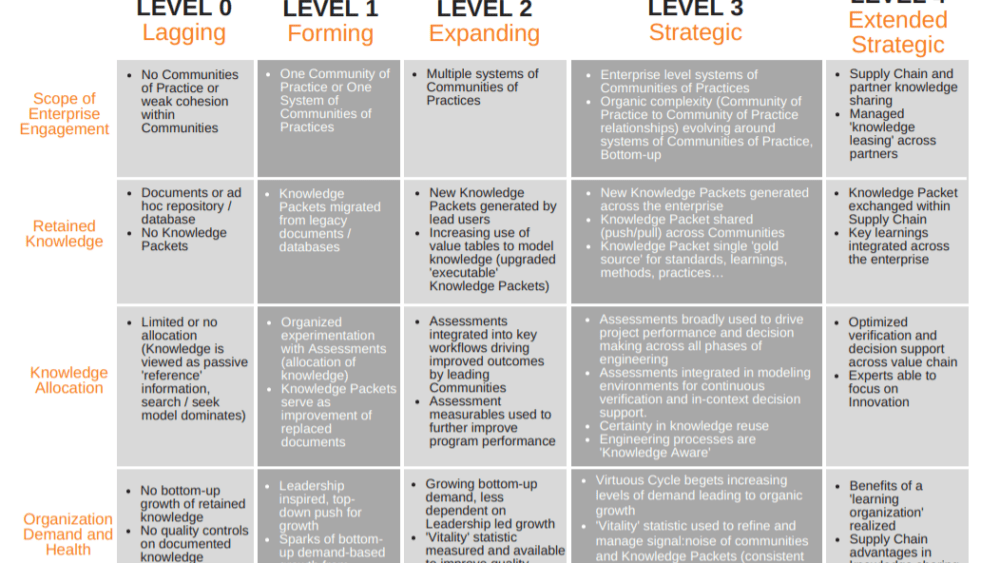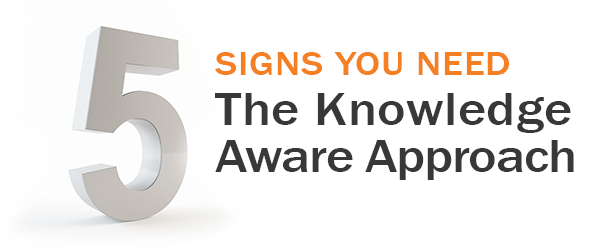The Knowledge Aware Maturity Model is an instrument to help organizations determine their level of maturity with regards to institutionalizing their most valuable asset, corporate technical memory, in accordance with the principles of the Knowledge Aware system.
The Maturity Model consists of three important components: the four key organizational features, the five maturity levels, and the Active vs. Passive Knowledge Index.
The four key organizational features contain groups of related processes and elements that are instrumental to the institutionalization of KA within an organization. They include the Scope of Enterprise Engagement, Retained Knowledge, Knowledge Allocation, and Organization Demand and Health.
The second important component refers to the five maturity levels. “Maturity” relates to the degree of formality and optimization of processes. By assessing the maturity of different aspects of Knowledge Aware, it becomes clear what their strengths and weaknesses are, and where improvements are needed. The five maturity levels are defined as follows:
Lagging (Level 0)
There is no organized level of managing or utilizing the corporate technical memory. Processes related to knowledge management are typically undocumented and strictly local in nature.
Local/Tactical (Level 1)
There is an initial recognition of the need for managing or utilizing corporate technical memory. Although still at the local level, there is an effort to apply structure that would address some ownership of the technical memory.
Replicating/Expanding (Level 2)
There is some stability in the processes for allocating and assessing knowledge. These processes have moved beyond being local and now extend to some degree across disciplines and organizations.
Strategic (Level 3)
Corporate commitment exists throughout the organization. Knowledge management is no longer considered a process of its own and is instead integrated within the organization’s daily processes.
Extended Strategic (Level 4)
The corporate commitment and application extends beyond the traditional boundaries of the enterprise. Bidirectional knowledge sharing with the supply chain further enhances the closed-loop learning cycle. Decision verification, assessment, and decision support exist across the value chain.
The third key component of the Maturity Model is the Active vs. Passive Knowledge Index. This is a central theme of Knowledge Aware, which ensures that corporate knowledge is active rather than passive in delivery and structure.
Active vs. Passive Knowledge Provisioning
Companies can use many different approaches for managing and allocating corporate knowledge within their organizations. These include both physical and electronic libraries, collaborative document repositories, training sessions, access to technical experts, and delivery through digital tools such as CAD. The effectiveness of these approaches depends on whether the particular application of the Knowledge Management systems is time-sensitive. For a Knowledge Management app that supports operational workflows, such as production, design, maintenance, and repair, the provisioning and application of knowledge becomes very time-critical.
When time is of the essence, it’s important that no time is lost searching for knowledge or interpreting how it should be applied. The Active vs. Passive Knowledge Index was developed to help realize this concept and to address organizational overall achievements to institutionalize processes that drive Active Knowledge Delivery and Active Knowledge Structure. There is little to no need for the individual to interpret the meaning of technical memory and how it needs to be applied.
In a passive Knowledge Management approach, knowledge is viewed as passive reference information. As a result, the traditional search model dominates. At the other end of the scale, an active approach is designed to provision relevant knowledge directly into workflows when and where it’s needed. Knowledge is not managed in documents, but as individual elements that can be harvested, networked, and delivered in packages to the user.
If you’re interested in assessing your own company’s level of maturity, visit aurosks.com/adoption-process.






Comments are closed.